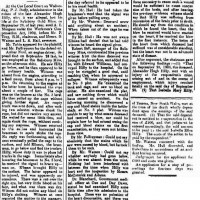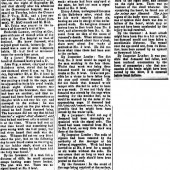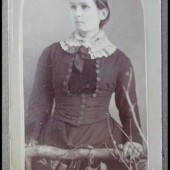Alexander Hugh HILLY
Age at Death24
Date Of Death28 September 1906 : Reg Murchison 54/1906
Place Of BirthYass, New South Wales
OccupationMiner
Name Of Mine On Which Last Employed
Salisbury GM, Cue, Western Australia
Diagnosis or cause of accident
General regret was expressed on Saturday morning when it became known that Mr. Hugh Hilly had suddenly died. At first it was thought that death was due to an accident, but it would appear that the cause was heart failure. The circumstances attending Mr. Hilly’s demise, however, make it necessary that an inquiry be held. It would appear that he was employed at his usual work at the Salisbury mine, on Friday night, where he was engaged as a platman. It is understood that something went wrong with the winding gear, and that deceased climbed for some little distance up the ladderway, and by some means, fell to the plat. The braceman, after waiting for some time, and not hearing the usual signal, descended to the level, and there found Mr. Hilly in an unconscious state, and apparently in a fit. There was a cut above the eye, and an abrasion on the arm, but the former was little more than skin deep. No time was lost by Mr Bell, the manager, in conveying the unfortunate man to the hospital, where he died shortly after admission.
Mr. Hilly, who was about twenty-four years, was a popular cricketer and generally esteemed for his quiet and gentlemanly demeanor, The funeral took place on Sunday, and the remains were followed to the cemetery by a large number of mourners, A short service was held at the Convent School by the Rev.-Father Byrne, who also conducted the burial service at the grave.
Among others, the following sent wreaths:—Messrs, W. Fisher and M. Reid, Mrs.Bone, Mr. and Mrs. F. Lawsen, Mr. B.Pratt, Railway Cricket Club and supporters, Dominican Nuns, Mr. and Mrs.Langdon,Mr. J Wright, Mr. W. McCormack, Mrs. Maguire and Mies Bardi.
Place Of Burial
Cue and Day Dawn Cemetery, Western Australia
Submitted by
Eric Chamberlain - Volunteer & Anne Martin (Relative)
MSW
Single
District
Cue
Cause of Death
Mine Accidents
Father
Felix HILLY : When Hugh Hilly was born in 1880 in Yass, New South Wales, his father, Felix, was 48 : Felix Hilly was born in 1832 in Enniskillen, Fermanagh. He married Catherine Mary Hingerty on 9 October 1871 in Yass, New South Wales. They had eight children in 13 years. He died on 12 August 1912 in Liverpool, New South Wales, having lived a long life of 80 years.
Mother
Catherine HINGERTY was 34 when Hug was born : When Catherine Mary Hingerty was born on 17 March 1846 in Goulburn, New South Wales, her father, John, was 41, and her mother, Isabella, was 20. She married Felix Hilly on 9 October 1871 in Yass, New South Wales. They had eight children in 13 years. She died on 4 August 1906 in Temora, New South Wales, at the age of 60.
Other Information
He had six brothers and one sister. He died on 28 September 1906 in Western Australia at the age of 26, and was buried in Cue, Western Australia.
The Salisbury Gold Mine is approximately 2 kilometres north of Cue, and 200 metres west of the highway. It is a north-south trending line of shafts and small mullock heaps.
In 1894 the area amounting to 48 acres is controlled by the Arcadia syndicate. In April 1895 it is purchased by an English syndicate, who form the Salisbury Murchison Gold Mining Co. The mine is developed with machinery, a poppet head, the shaft deepened and drives put in. The ore is crushed in batteries belonging to nearby mines. They also controlled the nearby Agamemnon Mine to the southwest. Crushing reports are noted between 1895 to 1897 when the mine was sold to another English company. They worked the mine for twelve months, and then applied for an exemption. The Warden refused, so the company applied again a month later, which was refused again, with a rebuke from the warden. .
In 1898, the nearby Gem of Cue mine takes an option over the mine. In 1902, the mine is operated by a Mr Harlick, who uncovered more gold at the 150 foot level. In 1904 the mine is taken over by Alf Morgan, who was Western Australia's fourth Premier for a short time in 1901. Sometime early 1907, Alexander Hilly was killed at the mine, and the local court instructed Morgan to make a pay-out to Hilly's sister as compensation. This was appealed through the Supreme Court, but Morgan lost, and closed the mine shortly after.
For the purposes of Mindat the Cue Goldfield encompasses the area north-east and north-west of Cue. The locations are both east and west of the Great Northern Highway in a 10 kilometre radius from the town. To the east the mines are north of the Cue-Wondinong Road, and westwards of the town the mines are north of the Cue-Beringarra Road, but before the Cuddingwarra group of pits. The Day Dawn goldfield borders to the south from here. Within this area are innumerable shafts, diggings, mullock heaps and tracks. The area historically contained five batteries at Cue One, Salisbury, Light of Asia, Gem of Cue and Cue Victory mines. There are at least forty major mines, operating from 1894 to 1920, when the area fell silent.
It is contained in a north east to east trending greenstone belt, intruded by granitoids. The greenstone consists of interlayered andesite to diactic volcanic rocks, ultramafic rocks, and komatiite, layered gabbro and sediments. There is also a significant intrusion of tonalite. A number of north-east striking shears and faults cut the succession. Parts of the field contain low plateaus of remnant laterite duricrust.
The gold is found in quartz veins hosted by granite, striking north-east or north north-west, dipping north-west or west, 200 to 1000 metres long, and up to 2 metres wide. These can reach up to 10 metres wide locally at cross reef intersections, or where the strike diverges. The veins reach 200 metres in depth. The granite hosted quartz veins show nuggety gold, over distances as short as a few metres. When metal detectors first became available, thousands of nuggets were recovered from the area. The gold is typically native, with minor sulphides or alteration minerals. The gold is erratic in distribution.
By 1897, they held the lease on the Queen of the May mine at Cue.
It was profitable for a while, but they found themselves in the Warden’s Court, accused by the owners of the adjacent Light of Asia, of tunnelling under their boundary. The Court found in favour of the Light of Asia and the three relatives lost everything.
By the time Hugh had his fatal accident, working on the Salisbury mine, Patrick was working in Menzies.
When Patrick heard of Hugh’s fate, he rode his bicycle for two whole days and a night to reach Cue by the evening of the second day.
Hugh and his brother, Thomas Hilly, arrived at Albany with their cousin, Patrick Duffy, on the steamer “New Guinea” on 14/08/1895
The two day ride by Patrick Duffy from Menzies to Cue was written up as a record at the time.
Patrick was my grandfather.




